Since prehistoric times, animals’ horns and tusks have given humans whatever the equivalent of penis envy for the forehead is.
Horns are majestic and grand: crowning emblems of warrior spirit, victory, and power. And sometimes you can drink mead out of them or make funny noises by blowing into one end.
Tusks are equally formidable; dense and powerful dental protrusions that are still worshipped by horrible piano makers to the point of almost wiping out entire species for their acquisition.
But aside from how they’re viewed by humanity, they’re also quite valuable to the animals who grow them and have evolved independently in multiple lineages, usually because of sex.
As an homage to some of our tusky, horny brethren (of whom we’re so jealous), we’ve compiled a list of some of the coolest examples.
In no particular order, here are ten animals with epic horns and tusks.
12. Markhor
The Markhor is a large wild goat from the family Bovidae, which is found in the mountains from Kashmir and Turkistan to Afghanistan.
They have majestic corkscrew-shaped horns a long beard and are referred to as the ‘screw-horned goat’ or ‘screw horn’ in Pakistan where they are the national animal.
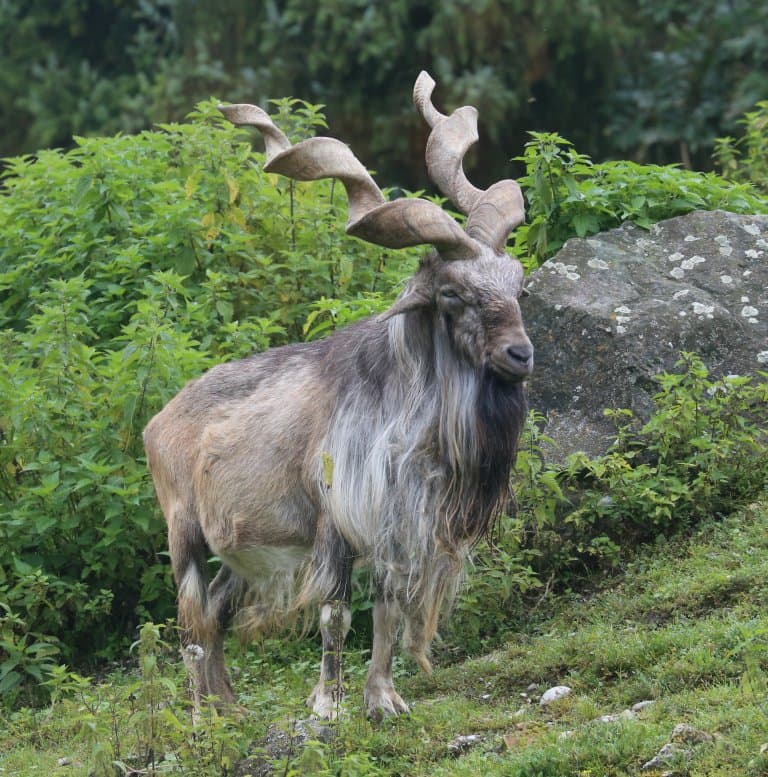
Both males and females can have corkscrew horns, with males growing over 60 inches (160 cms) in length, while female horns typically only grow to 10 inches (25 cms).
While Markhor will use them in defence against predators, they will also use them against other males when fighting for a mate.
The wildlife department in Pakistan issues permits to selected bidders for trophy hunting of markhor and other species each year. The award of an annual markhor trophy hunting permit fetched a whopping $160,250 for a single markhor to be hunted by one bidder!
11. Walrus
Walrus tusks are present in both males and females, but those of the male can grow to enormous sizes. They’re made of a material known as morse, or Walrus ivory, which has been commercially carved and traded much like elephant ivory, since antiquity.
Their tusks can reach an incredible 1m (over 3ft) in length.
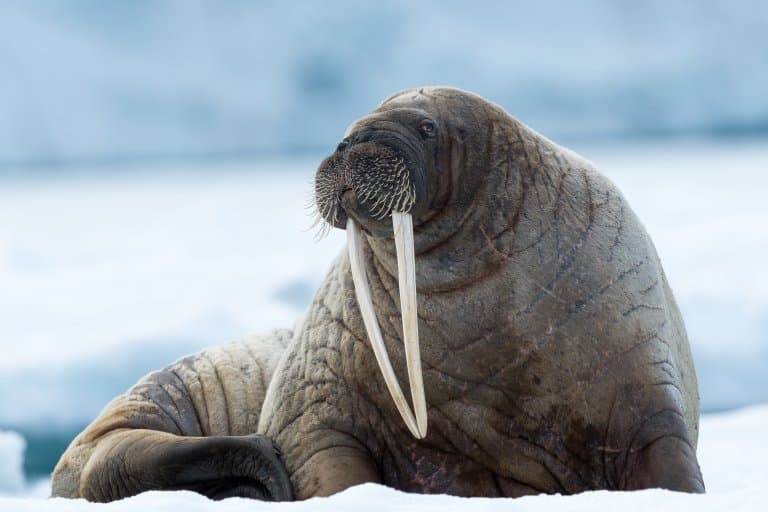
These battle tusks are modified upper canines and are used as ice picks to pull the girthy beasts out of the water, or when shouting at one another isn’t working. Walrus battles can be bloody affairs and are often fatal as a result of these sharp, piercing tusks.
They’ve also been known to attack and kill people in boats, as described in Four Years in the White North by Donald MacMillan,
“In 1908, a bull walrus attacked Sipsoo, an Etah native, capsized his kayak, cut his throat, and left him for dead. In 1910, Arkilo, one of the best and most skilful hunters in the tribe, was attacked and nearly lost his life. The walrus whipped around when harpooned, rushed at Arklio, and drove his tusk completely through his arm”.
10. Water Deer
Water deer are far less likely to penetrate a human physically, but have intruded into the social consciousness as bizarre mutant vampire spirits that combine the cutesiness of a fluffy deer with the threatening fangs of a bloodsucker.
The tusks are quite small, at around 5cm (2 inches) long, but then, so is the host, at around half a meter tall.

Again, these are upper canines, which is quite common in tusks, and they represent a rather primitive deer morphology, thought to have existed before the time of antlers, and would have been replaced in more modern species.
As such, the tusks work very much in the way antlers do in other deer: as a way of displaying virulence and shutting down any arguments to the contrary. 1
9. Alpine Ibex
The Alpine Ibex is a large mountain goat with horns that curve backwards over its head and powerful, muscular frames on spindly legs. They are one of the most iconic animals in the mountains of Europe and have equally revered cousins dotted around mountain ranges all over the world.
Alpine Ibex have backward-curving horns with ridges that can grow up to 55 inches (140cms).

Female horns are generally smaller, while males are longer and curvier. Their horns grow throughout their lives, and are used for fighting and protection.
Before real medicine (and still to this day among some particularly stubborn populations) humans took the simple view that if a particular animal had horns, killing it and eating that horn could give them the horn, so to speak.
The Ibex was one of the victims of this nonsense and was hunted to almost extinction to meet the demand for Ibex horn as a cure for impotence.
8. Rhino
Moving away from tusks for a moment, we come to the first horny animal in this list. While tusks are always extended teeth, true horns are a bony protrusion covered in keratin, the protein that makes hair and fingernails, horses hooves, and smells really bad when you burn it.
Rhino horn is a bit of a misnomer, in that it isn’t true horn. It doesn’t appear to have a bony protrusion at all and is simply a keratinous growth on the face.
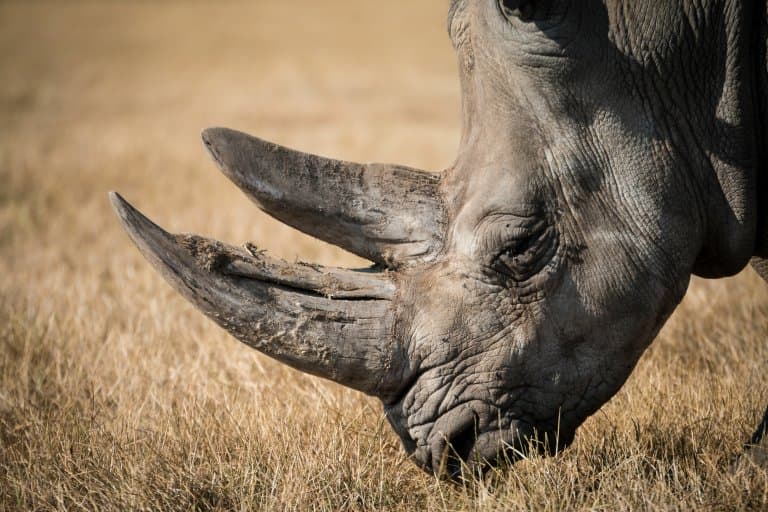
Still, it’s horny enough to make it onto this list, because it’s something that humanity appears to have lost their minds about. Rhino horn is one of the most expensive materials on earth, and this insanity is compounded by the fact that it’s almost entirely useless to anyone but the rhino.
Being rather grumpy animals, rhinos don’t hand over their horns willingly and thus are killed by idiots to sell to richer idiots, to the point where there aren’t many rhinos left.
Rhino horn is far more than a traditional medicine, it’s a status symbol, and rhino decline is consequently a symbol of wealth inequality and the (self-) destructive power of the human ego. 2
7. Scimitar Oryx
With that out of the way, let’s look at some real horn. Particularly astute observers may look at the scimitar oryx and wonder if the headdress it’s sporting isn’t some kind of antler, which, by definition, would disqualify it from a list of horny animals.

But like all antelope, the oryx is a bovid, and despite looking more deer-like, its exceptional protrusions are bony plates covered in keratin.
Males and females have horns, though those of the males are more robust. The horns are long, thin and curved backwards, designed for jabbing at pursuing predators, and extremely fit for purpose; oryxes can kill lions with these horns, and that’s exactly why they grow them.
Some say that the unicorn mythology comes as a result of seeing the oryx, and regardless, they have been revered by ancient cultures, including the Egyptians, who might have tamed them once.
6. Bighorn Sheep
Rams don’t come up much nowadays as symbols of power. The lack of good sheep PR has reduced the ruminant’s image to that of a bleeting, bumbling fool that’s only good for a Sunday roast.
But historically, rams were popular animals, capable of great feats of strength and proud, powerful mammals. The Bighorn sheep upholds this tradition as best it can in the face of changing attitudes, and sports some of the most impressive horns of any caprid.
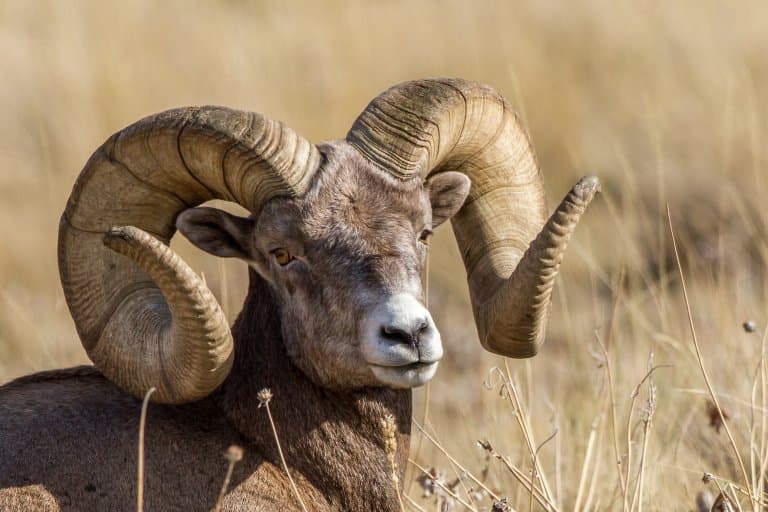
These large, curved horns are incredible weapons and are put to good use in the Rocky Mountains where this species is found. Males can collide 14 kg (30 lb) sets of horns at over 32km/h (20 mph), resulting in a clash that can be heard echoing through the mountains.
Remarkably, these thick-skulled animals usually walk away from such altercations apparently unharmed. 3
5. Babirusa
Let’s get back to tusks for a moment, and give the babirusa the attention it deserves. This pig is an ugly beast, inspiring demonic masks and legends from Indonesian tribes as a result of their peculiar tusks.
Perhaps the most uncomfortable-looking adornments on this list, the tusks of the babirusa are prehistoric-looking upper canines that instead of protruding straight downwards, curve back up and over the face.
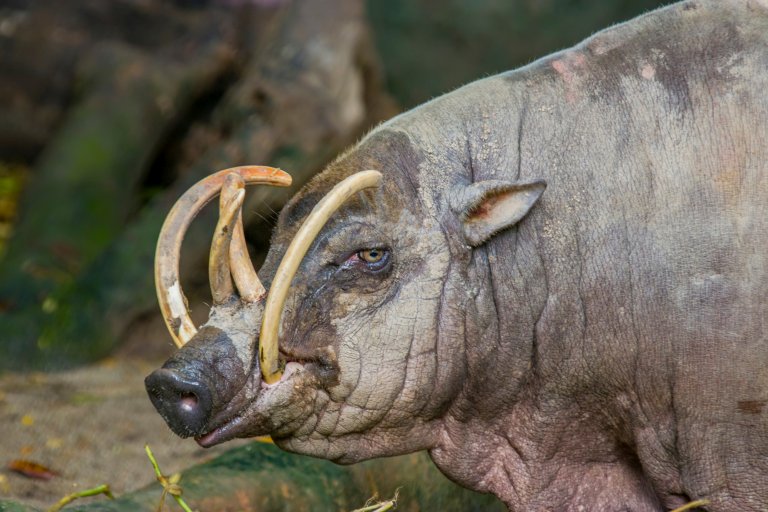
In males, this pierces the flesh of the snout, curving around to poke him in the forehead, which sounds like a form of torture and is a testament to the disregard that nature has for the individual.
Interestingly, these tusks are flimsy and of no use in a real fight, so why they’re there is a bit of a grotesque mystery, but they might protect the eyes from the much more functional lower tusks, which protrude outwards like spears.
4. Hippo
Hippos are well known for looking like they’ve never been to the dentist, and despite giving the animal the most brutal morning breath, they’ve served it well.
Hippos have one of, if not the, most powerful bites in the animal kingdom. Their skulls are immense and have huge connection surfaces for the crushing jaw muscles, and on the inside of the mouth sit canines that can reach a meter long.

These aren’t used for eating soup, either. Hippos are supremely violent animals and will gladly stab at their foes with these tusks.
A human caught in these teeth is likely to pop like a watermelon, but they’re more commonly used by males to argue over the large harems of wallowing, farting females that are apparently so desirable to them. 4
3. Strap-toothed Beaked Whale
Beaked whales eat a lot of squid and soft fish, and as a result, have generally lost the ability to chew.
They don’t really have teeth any more, aside from a pair of protruding lower teeth that in the strap-toothed species, curve up and over the snout like a dentine belt.
These weird tusks can grow up to 34 cm long, and can even overlap one another, making it hard for the owner to fully open its mouth.
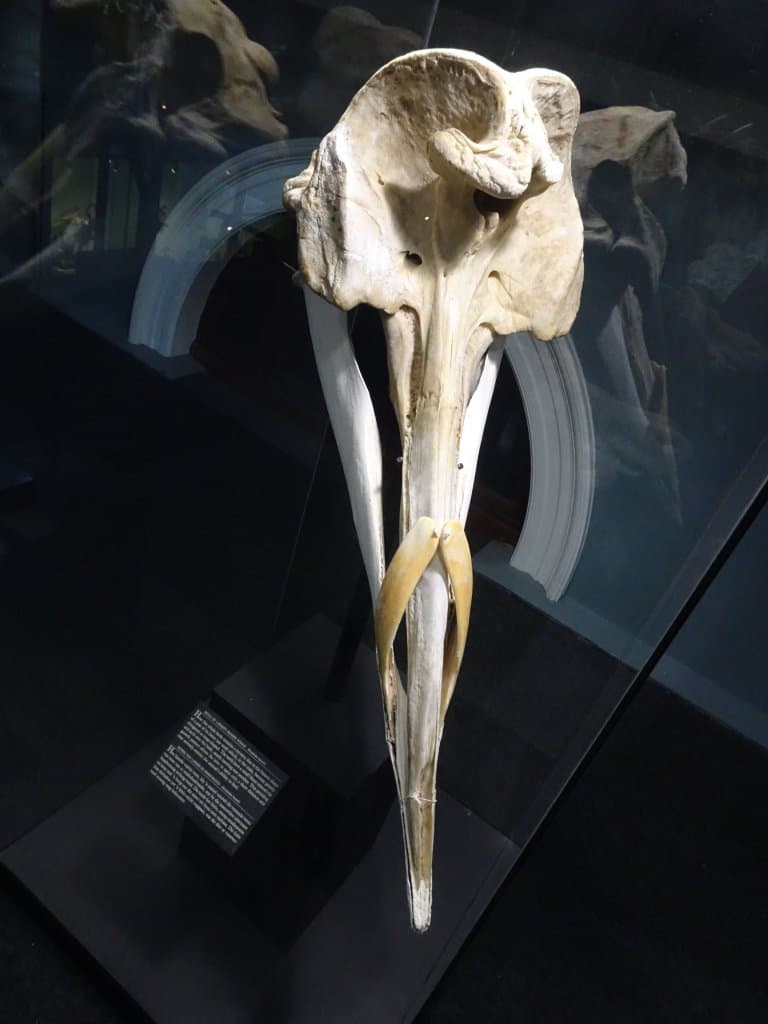
Again, this is an example of the great F.U. that evolution routinely extends to the individual as long as it helps to pass on the genes.
The strange thing is, that we don’t really know how this facial deformity helps the breeding of the species. Direct physical competition is the obvious answer, but it hasn’t been witnessed because the whales are so elusive.
It might also be some way of distinguishing one species from another, as the rest of the animal is hard to tell apart from the numerous other beaked whale species on the market.
Another interesting thing about this tusk is that it has its own tusk! A small denticle protrusion on the surface of the tusk gives this whale an inception-style weapon on its face at the cost of not being able to eat properly. This US military budget approach to survival shows the bizarre priorities that nature values.
2. African Elephant
This one is almost too obvious for this list, but it’s worth putting up on account of how elephant tusks are changing with recent evolutionary leaps.
Natural selection favours the phenotype (shape) that best suits its environment and generally kills off or otherwise handicaps the reproduction of the rest.
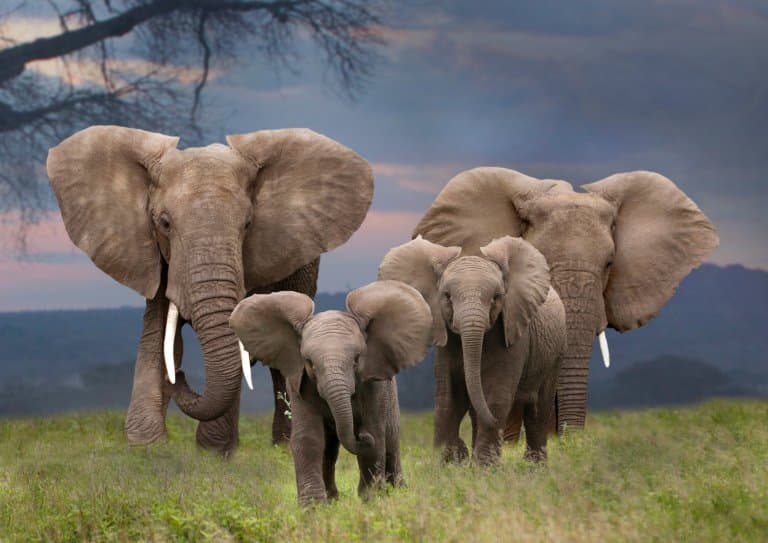
In elephants, their environment has changed to one of immense persecution towards those with the most epic tusks. Like the rhino, it’s a cascade of idiocy that’s wiping out the entire African species, but their evolution may provide a solution.
As this new threat increases, selection is favouring elephants born with smaller tusks. They’re not as prized, so they don’t get as shot, and as such pass on their small-tusk genes to more offspring.
Elephant tusks are highly prized for their ivory, which grows out of incisors in both male and female elephant’s jaws.
Elephants demonstrate a preference for these tools, just as humans are right or left-handed, and they’re used to manipulate their environment, stripping bark off trees, clearing walkways, and protecting the intricate trunk from damage.
As victims of the illegal wildlife trade, each year, elephants are killed in their tens of thousands by poachers just to get hold of these tusks. 5
1. Narwahl
The most defining characteristic of the narwhal is what led to it being named ‘one tooth one horn’, which puts it at the top of the list for being horny and tusky.
In reality, narwhales don’t have any horns, and the protrusion from the front of its head is a single tusk, usually from the left upper canine that pierces its lip and spirals out into a truly glorious, 3-meter staff.
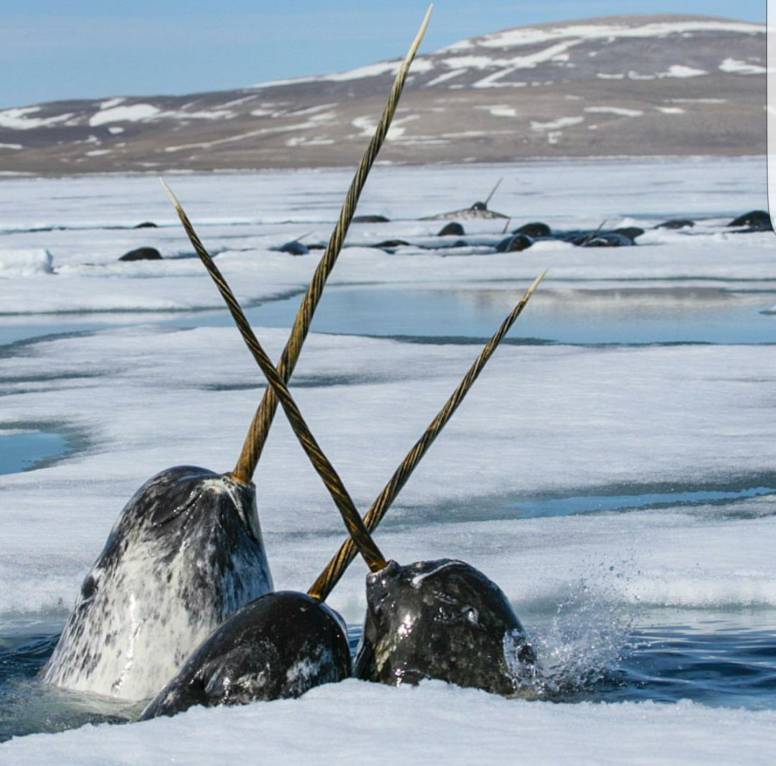
Despite its enormous size, this hollow tusk is surprisingly light at around 10kg, and is most commonly seen in males, but also occurs in roughly 15% of females.
Because of its lightweight, it’s more likely to be used to show off than to fight with, but recent dives into narwhal tusks have shown that it might also be hugely sensitive and used to navigate the world.
Rubbing tusks together – something that was once thought to be aggressive behaviour – might, in fact, function as a communication device, sharing information between individuals and incredibly conjuring up far more questions than it answers about the most notorious tusk in the Northern Hemisphere. 6
Final Thoughts
Tusks and horns have been a subject of fascination for the Naked Ape, likely since before the dawn of ‘man.
They’re symbols, weapons, communication devices, armour, and navigational tools, and come in all shapes and sizes across the animal kingdom.
But if there’s anything to learn from the effect that this curiosity has had on our global ecosystems, it’s that these horns and tusks are much better left attached to the animal.
Our need to “own” things we like the look of is something that betrays a deep-rooted disrespect for the agency and contribution of the other animals on this planet, and in many cases has led not only to their destruction but the consequent weakening of the environment that we, too, share.
If we can move past a primitive urge for status symbols and arbitrary hierarchies, we might find that we are more similar to these animals than we are different, and perhaps then they’ll survive long enough for us to envy their horns for millennia to come.
Fact Sources & References
- “Chinese water deer“, BDS.
- Jeremy Hsu (2017), “The Hard Truth about the Rhino Horn “Aphrodisiac” Market“, Scientific American.
- PJ DelHomme (2023), “Back from the Dead: Montana Bighorn Sheep Restoration“, Crazy Canyon Journal.
- Barry K.B. Berkovitz (2013), “In Nothing but the Tooth“, Science Direct.
- “What is ivory and why does it belong on elephants?“, WWF.
- “Narwhal“, WWF.
